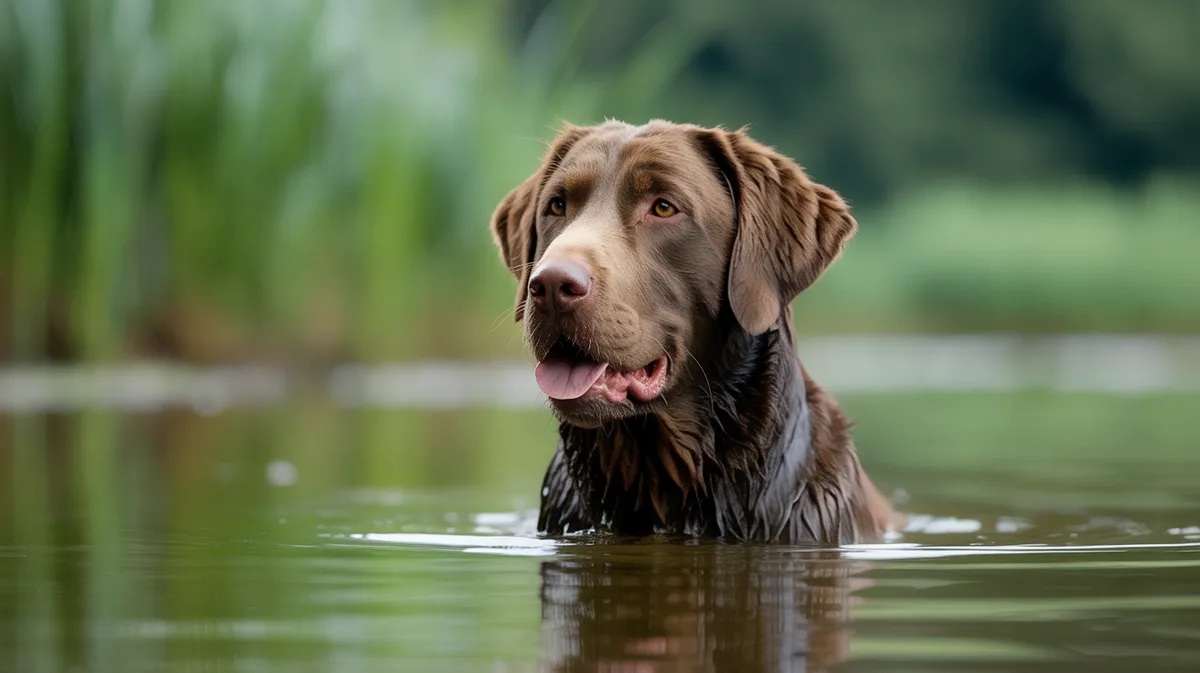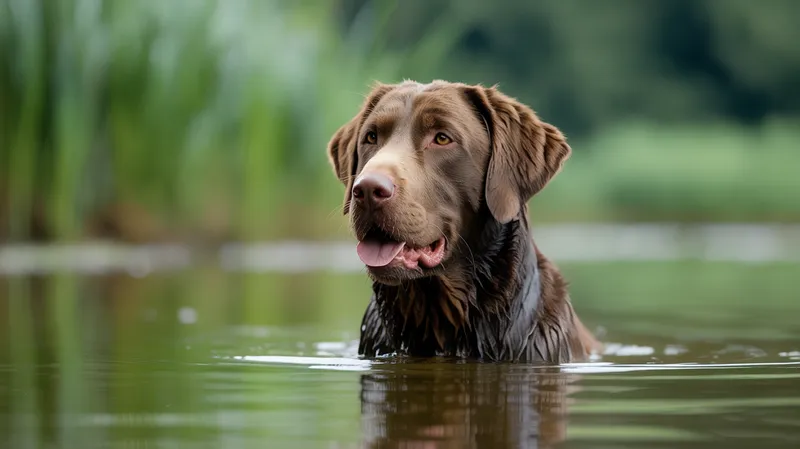
Chesapeake Bay Retriever
Canis lupus familiaris

Meet the Chesapeake Bay Retriever
The Chesapeake Bay Retriever is a robust and hardworking breed originally developed in the United States for retrieving waterfowl in the challenging conditions of the Chesapeake Bay. Known for its dense, waterproof double coat, this dog excels in swimming and is highly valued for its endurance and intelligence. The breed is loyal, protective, and often reserved with strangers, making it both an excellent hunting companion and a devoted family dog. With a muscular build and keen problem-solving ability, 'Chessies' are also employed in search and rescue and therapy work.
Classification
Mammal
Habitat
Coastal wetlands and freshwater environments (primarily as a domestic and working dog)
Diet
Omnivore
Lifespan
10-13 years
Conservation
Least Concern
Weight
55–80 lbs (25–36 kg)
📖Fascinating Facts
Waterproof Coat
Their dense, oily double coat provides insulation and repels water, making them ideal for cold-water retrieving.
Webbed Feet
Chesapeake Bay Retrievers have webbed toes, giving them superior swimming ability compared to many other dog breeds.
Duck Hunting Specialists
They were specifically bred to retrieve hundreds of ducks a day under harsh weather conditions in the Chesapeake Bay area.
📋Detailed Description
The Chesapeake Bay Retriever is a powerfully built, medium to large sporting dog, typically standing 56–66 cm (22–26 in) at the shoulder and weighing 30–45 kg (66–100 lb), with males generally larger than females. Its most distinctive anatomical feature is a dense, oily, waterproof double coat: the outer layer is harsh and wavy, while the undercoat is fine and woolly, providing insulation against frigid water temperatures. The breed has a broad, rounded head, strong jaws, and muscular neck and shoulders, facilitating the retrieval of heavy waterfowl and swimming against strong currents. Their webbed feet and slightly longer hind limbs enhance aquatic propulsion. Behavioral studies note a high degree of intelligence, problem-solving ability, and an independent but loyal temperament. Chessies are known for their stamina, courage, and determination, often working tirelessly in adverse weather. Socially, they form strong bonds with family members but are typically reserved or aloof with strangers, a trait likely selected for in their historical role as property guardians. Reproduction is typical of domestic dogs, with litters averaging 7–10 puppies. Unique among retrievers, Chessies exhibit a pronounced protective instinct and a tendency toward single-family loyalty, reflecting their dual heritage as both working and companion animals.
💡 Did you know?
The breed's origins trace back to two Newfoundland dogs rescued from a shipwreck in 1807, whose descendants were bred with local retrievers to create the Chesapeake Bay Retriever.
🔬Research & Sources
Wikipedia Summary
The Chesapeake Bay Retriever is a large breed of dog belonging to the retriever, gundog, and sporting breed groups. The breed was developed in the United States Chesapeake Bay area during the 19th century. Historically used by local market hunters to retrieve waterfowl, pull fishing nets, and rescue fishermen, it is today primarily a family pet and hunting companion, known for a bright and happy disposition; courage; willingness to work; alertness; intelligence; love of water; and hunting capabilities. The Chesapeake is a medium- to large-sized dog similar in appearance to the Labrador Retriever, but with a wavy coat.
Last Modified: 2/1/2025
🎭Behavior & Social Structure
Chesapeake Bay Retrievers are highly energetic and require substantial daily exercise, including swimming, running, and mentally stimulating activities. Their hunting behavior is characterized by persistence and a methodical approach; they are known to retrieve hundreds of birds in a single day, demonstrating remarkable memory and directional sense. Feeding behavior is omnivorous, but as domestic dogs, their diet is managed by owners. Socially, Chessies are generally tolerant of other dogs but may display dominance, especially among males. They thrive on routine and clear leadership, responding best to positive reinforcement and consistent training. Daily routines often include periods of intense activity followed by rest, and they are known for their 'soft mouth'—the ability to carry game gently without damage. In the home, they are affectionate with family, protective of children, and alert to unusual occurrences, making them effective watchdogs.
👶Reproduction & Life Cycle
Chesapeake Bay Retrievers reach sexual maturity between 6 and 12 months, though responsible breeding typically occurs after 2 years of age to ensure physical and behavioral maturity. The breed exhibits no marked seasonality in estrus, with females cycling approximately every 6–8 months. Mating is usually natural, and gestation lasts about 63 days. Litters commonly range from 7 to 10 puppies, though larger litters are not uncommon. Parental care is primarily provided by the dam, who nurses and grooms the puppies for the first 3–4 weeks, after which weaning begins. Breeders emphasize early socialization to mitigate the breed’s natural wariness and to foster adaptability. Puppies are generally ready for adoption at 8–10 weeks, by which time they have begun basic training and exposure to water.
🛡️Adaptations & Survival
The Chesapeake Bay Retriever’s most notable adaptation is its water-resistant double coat, which contains natural oils that repel moisture and insulate against cold. The breed’s webbed toes and strong, muscular limbs are specialized for efficient swimming, even in icy or turbulent waters. Their keen sense of smell and acute vision aid in locating downed birds over long distances and in dense cover. Behaviorally, Chessies exhibit a high pain threshold and resilience to harsh environmental conditions, traits selected for during their development as working dogs in the challenging Chesapeake Bay region. Their independent problem-solving ability allows them to navigate complex retrieval scenarios without constant human direction.
📚Research Sources
🎨Cultural Significance
The Chesapeake Bay Retriever is the official state dog of Maryland, symbolizing the region’s rich waterfowling heritage. Historically, the breed played a crucial role in the livelihoods of Chesapeake Bay market hunters, retrieving waterfowl, pulling fishing nets, and even rescuing fishermen from the frigid bay. The Chessie is celebrated in local folklore and art, often depicted as a symbol of perseverance, loyalty, and rugged individualism. Today, the breed remains a popular choice among hunters and outdoor enthusiasts and is increasingly recognized for its service in search and rescue, therapy, and detection roles.
🔬Recent Research & Discoveries
Recent genetic studies have traced the Chesapeake Bay Retriever’s ancestry to a mix of Newfoundlands, Irish Water Spaniels, and local hounds, confirming historical accounts of its development. Ongoing research focuses on genetic markers for inherited diseases, with the aim of improving breed health through selective breeding. Studies on canine cognition have highlighted the Chessie’s advanced problem-solving skills and memory, particularly in complex retrieval tasks. Behavioral research continues to explore the breed’s unique combination of independence and trainability, providing insights into optimal training methods and socialization practices.
🎥Wildlife Videos

The Role of Chesapeake Bay Retrievers in Waterfowl Habitat Preservation
Chesapeake Bay Retrievers and Their Role in Waterfowl Habitat Preservation The Chesapeake Bay Retriever is a majestic and ...
Chesapeake Bay Retriever USA

Meet the Chesapeake Bay Retriever: A Dog with a Special Purpose in Wildlife Conservation
Can Chesapeake Bay Retrievers be used in wildlife conservation efforts? Chesapeake Bay Retrievers, also known as Chessies, ...
Chesapeake Bay Retriever USA

Discover the Loyal Chesapeake Bay Retriever: Fascinating Facts Revealed! #amazingfacts #wildlife
Did you know that the Chesapeake Bay Retriever is a breed known for its exceptional swimming ability and strong work ethic?
Amazing Facts of ...

Treasures of the Chesapeake
Directed and Produced by Christopher Lapinski Narrated by Christie Crossley Director of Photography Christopher Lapinski ...
Christopher Lapinski

Hunting video and pictures with 3 Chesapeake bay retrievers 2024 - 25
Funny video on a snowy day after a successful pheasant hunt with 3 Chesapeake bay retrievers plus additional pictures.
SchaeferSteve

Chesapeake Bay Retriever in Action
Here's a custom YouTube channel description for **GSJ VIDEOS**, focused on nature content, with relevant hashtags: ...
GSJ VIDEOS
🌍Habitat Information
The Chesapeake Bay Retriever typically inhabits Coastal wetlands and freshwater environments (primarily as a domestic and working dog) environments. Chesapeake Bay Retrievers have adapted to their environments with specialized features and behaviors.
Primary Habitat:
Coastal wetlands and freshwater environments (primarily as a domestic and working dog)
More detailed habitat information will be available soon.
🛡️Conservation Status
The Chesapeake Bay Retriever is currently classified as Least Concern. Conservation efforts are crucial for preserving this species for future generations.
Common Threats:
- 🏠Habitat loss and fragmentation
- 🌡️Climate change impacts
- 🎯Hunting and poaching
- 🏭Human-wildlife conflict
⚠️Threats & Conservation Challenges
As a domestic breed, the Chesapeake Bay Retriever is not threatened in the wild, and its conservation status is 'Least Concern.' However, the breed faces challenges related to genetic diversity due to a relatively small founding population and popularity fluctuations. Hereditary health issues, such as hip dysplasia, progressive retinal atrophy, and exercise-induced collapse, are of concern and are monitored by responsible breeders. Human impact is primarily positive, as the breed is maintained through dedicated breeding programs, though irresponsible breeding or lack of adequate exercise and mental stimulation can lead to behavioral problems. Population trends are stable, but the breed remains less common than other retrievers, such as the Labrador or Golden Retriever.
🔬Scientific Classification
Scientific Name
Canis lupus familiaris
Classification Hierarchy
🔍 About Taxonomic Classification
Taxonomic classification is a hierarchical system used by scientists to classify and organize living organisms based on shared characteristics and evolutionary relationships.
The system moves from broad categories (Kingdom) to increasingly specific ones, with each animal's scientific name typically consisting of its Genus and species.
📝Community Notes
Share your observations and insights about the Chesapeake Bay Retriever with our community of wildlife enthusiasts.
Join Our Community
Sign in to share your observations and connect with fellow wildlife enthusiasts.
Sign In to ContributeNo community notes yet
Be the first to share your observations about the Chesapeake Bay Retriever!
Explore Chesapeake Bay Retriever
Select a tab above to learn more about this amazing animal.
📸Photo Gallery
No photos available for this animal yet.
🌟Discover More Wildlife
Continue your journey of discovery with more fascinating animals from our database
